Some remarks about...
**** WITTIA AMAZONICA ****
**** or DISOCACTUS AMAZONICUS ****
** or PSEUDORHIPSALIS AMAZONICUS **
__________________
PAGE 2/3
____________________
From now, I will speak (as regards my collection) only about the first clone photographed on the previous page, and which I bought in 1996 from Matthias Uhlig (Uhligkakteen) in Germany. Matthias used to grow it and got abundant blooming in a special part of his greenhouse, above a basin filled with water, therefore in a very wet air, and at a temperature never below 18°C.
The growing conditions in my greenhouse are far from being identical since I grow this plant as I do my other epiphytic cacti, with a minimal temperature of 9 to 12°C and a relative humidity being able to go down to 60%. During the summer, I place the plant in a shaded area in my garden where it lives at the rhythm of the Paris region's climate, rather wet but sometimes a little bit cold (11 to 13°C during the night is not exceptional in July, August and September).
After a few years, I got disappointed and I wondered about the reasons for winter necroses and for nonblooming.
Then I decided to winter (for 2 to 3 years) my plant inside my house, under a horticultural neon tube, with a minimal temperature of approximately 16°C and a relative humidity between 40 and 50%. The result was not very conclusive : necroses only slightly attenuated and still no blooms. On the other hand I learned something very surprising regarding ......resistance to the cold .
AN INCIDENT AS EXCEPTIONAL AS INSTRUCTIVE.
At a time when I was absent from home, during the 2002 Christmas
holidays, I decided to transport some fragile plants to a friend's house because
I had decided to reduce the heating in my house. Among these plants was obviously
my dear Wittia amazonica. But I made the removal during the night,
and, in the precipitation of my departure, I forgot Wittia amazonica in the
boot of my car!! Beforehand, I had abundantly watered the compost to reduce
the task of watering for my friend. Thus the plant remained during approximately
two weeks in the darkness of the boot of my car, parked on the parking lot
outside my house. During my absence, the outside temperature fell, at least
during one night to 12°C BELOW ZERO. When I realized my lapse of
memory, after my holidays, I was quite sure that my plant was definitively
dead. But, as it did not appear damaged, I put it in my cold greenhouse and
I decided to observe it during a few days. Some stems softened and blackened,
they had been damaged by frost. To my great surprise, other articles apparead
to be intact and I decided to make cuttings with it. In addition, I kept the
mother plant. Some months later, the mother plant died; on the other hand,
the cuttings of the non frozen stems succeeded and thus I could keep the plant.
What a good example of resistance to cold!!
Since this incident, I again have grown Wittia amazonica in my cold greenhouse, as I did at the beginning. But, from 2003 to 2008, I didn't observe any bloom, just some floral buds which soon fell.
Thus my method of growing appeared to be wrong and I wanted to compare with another one.
OTHER CONDITIONS OF GROWING.
Fortunately, Michel Monnier, a friend and also a neighbour of
mine, has a glazed and heated approximately two-meter-long terrarium in his
cold greenhouse. In there, he grows plants originating from south-east Asia
and Australia (Thailand, Vietnam, Malaysia, Indonesia, North of Queensland),
which are myrmecophiles:
which means that they live in symbiosis with ants which live in the caudex
plants; in exchange, they nourish their hosts with their dejections which
they deposit in specialized rooms of the caudex.
They have in common to grow naturally between 15° of Northern latitude and 15° of Southern latitude, in areas of low altitude, very wet and hot.
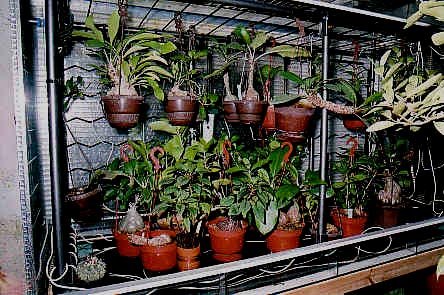
General sight of terrarium and the wires which heat the layer of water
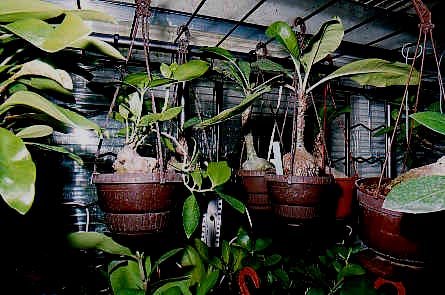
Some myrmecophiles
The thermal and hygrometrical conditions of this terrarium particularly interested me for different reasons : a temperature always ranging between 20°C and 40°C and a relative humidity of about 100%, a ground of terrarium being always covered by a layer of water heated by sheathed electric wires. Thus, approximately two years ago, I gave my friend a specimen of my Wittia to see what it would do under such conditions, so different from mine. The plant was grown in a hanging pot above the layer of water, in peat, and a shaded situation.
I was pleasantly surprised when Michel called me one day of spring 2008, to tell me that Wittia was in bloom and that the bloom was partially blue!! My friend had obtained a blooming much more quickly than me.
And, supreme luck, in my greenhouse I observed floral buds on Wittia amazonica ; I thought that they would soon fall too, as usual ; I was wrong, they grew until complete blossoming.
I immediatly thought that Wittia amazonica was the only Cactacea whose flower contained blue pigments. Thus, in my opinion, it was possible, by selection and/or hybridization, to use it to obtain the first Cactus with blue blooms.
It would be a bit premature. An article of Alain Laroze in « Le Cactus Francophone » (you may click on the link at the end of the article) reminded me that plant colours are due to two main families of pigments : betalains and anthocyanins ; these families cannot coexist in a plant. In particular , the cacti do not contain anthocyanins which are replaced by betalains. The betalains are divided into two groups : the betaxanthins (yellow colour) and the betacyanins (red to violet colour). A betalain with blue colour does not exist, so the obtention of a cactus with blue blooms seems to be impossible.
The blue colour of the Wittia amazonica petal tips
seems to be due to the structure of the blooms' surface cells (reflection
of the rays ?), and not to pigments.
COMPARED RESULTS OF THE TWO METHODS OF GROWING.
Here I show, one after the other, two blooms of the same clone of Wittia amazonica : the first one grew and opened in my friend's hot and wet terrarium, I obtained the second one in my greenhouse where the atmosphere is drier and colder.
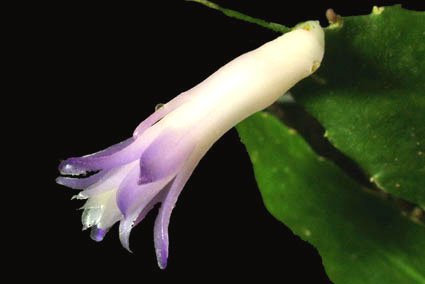
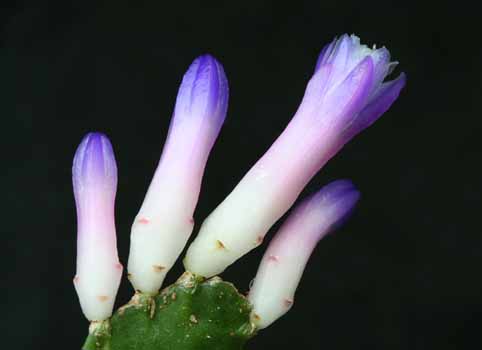
flowers obtained in my friend's terrarium
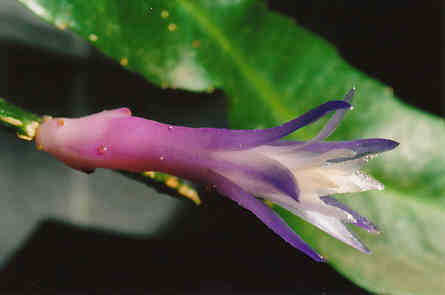
flower obtained in my greenhouse
The two blooms, of the same size, show obvious differences: the first ones have a white tube, whereas the second has a pink one. The blue colour of the second bloom appears more intense than the one of the first bloom.
In my opinion, these differences are mainly due to the difference
in temperature of growing. The variability of the color of the blooms is particularly
obvious among Schlumbergera : Schlumbergera with white or yellow blooms have
an additional pinkish colouring when the temperature falls below around 15°C
from the period when the buds are formed until the floral blossoming ; and
pink colouring is increasingly intense when the fall of the minimal temperature
is more important. In a more general way , other Schlumbergera have also a
floral color sensitive to the temperature : hotter temperatures give among
certain hybrids clearer more pastel nuances whereas colder temperatures give
darker and more crimson colouring. In all cases, the whiteness of the floral
tube, when it is white in hot temperature,
becomes pink and darkness increases when the temperature is lower.
I also observed this thermosensitivity of the floral color among certain Epiphyllum (X King Midas for example whose only clone can give orange pale blooms or, on the contrary, blooms which have a sharp orange to red colour).
This could also explain (apart from any error of labelling) why the plants we grow do not always show colours strictly in conformity to those of the catalogue of the producer from whom we ordered. A few years ago I had discussed with Chuck Everson from Rainbow Gardens and for whom growing conditions influenced the color of blooms.
It's quite obvious that in the event of too important difference, the question of wrong identification is sometimes the right reason. (If I may say so.)
GO TO PAGE 3/3 BACK TO PAGE 1/3
_____________________________________________________________